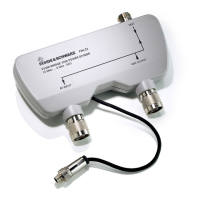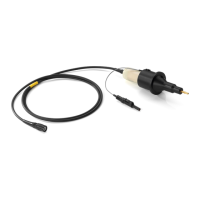Safety and regulatory informationMXO 4 Series
20User Manual 1335.5337.02 ─ 07
Performing measurements
Take the following measures for your safety:
●
To ascertain a voltage-free state, use an appropriate voltage tester. Any measure-
ment setup including an oscilloscope is not suitable for this purpose.
●
The maximum input voltage on channel inputs and the external trigger input must
not exceed the value specified in the specifications document.
●
Observe all voltage and current ratings of the instrument, the probes, and the
accessories. Exceeding the allowed voltages can lead to an electric shock.
Limits and ratings are marked on the products and listed in the specifications docu-
ments.
Consider that the rated voltage depends on the frequency. The voltage limitation
curves or values are provided in the specifications document.
●
Never cause any short circuits when measuring sources with high output currents.
●
Use only probes and accessories that comply with the measurement category
(CAT) of your measurement task. If the product is rated for any measurement cate-
gory, the permitted category is indicated on the product and in the specifications
document. If you use other than Rohde & Schwarz accessories, make sure that
they are suitable for the instrument and the measurement task.
●
Set the correct attenuation factor on the instrument according to the probe being
used. Otherwise, the measurement results do not reflect the actual voltage level,
and you might misjudge the actual risk.
●
When working with high voltages and current probes, observe the additional oper-
ating conditions specified in these safety instructions.
●
The probe pins are extremely pointed and can easily penetrate clothes and the
skin. Handle the probe pins with great care. To exchange a probe pin, use tweez-
ers or pliers to avoid injuries. When transporting the accessories, always use the
box supplied with the probe.
●
Prevent the probe from receiving mechanical shock. Avoid putting excessive strain
on the probe cable or exposing it to sharp bends. Touching a broken cable during
measurements can cause injuries.
●
Set up all probe connections to the instrument before applying power.
Working with hazardous voltages
Voltages higher than 30 V RMS, or 42 V peak, or 60 V DC are regarded as hazardous
contact voltages. Direct contact with them can cause serious injuries.
Make sure that only electrically skilled persons use the products for measurements on
hazardous contact voltages. These working conditions require special education and
experience to perceive risks and to avoid hazards which electricity can create.
When working with hazardous contact voltages, use protective measures to preclude
direct contact with the measurement setup:
●
Do not touch exposed connections and components when power is applied.
●
Switch off the test circuit while connecting and disconnecting probe leads.
●
Use only insulated voltage probes, test leads and adapters.
●
Make sure that the input leads fulfill the safety requirements for your measurement.
Safety instructions

